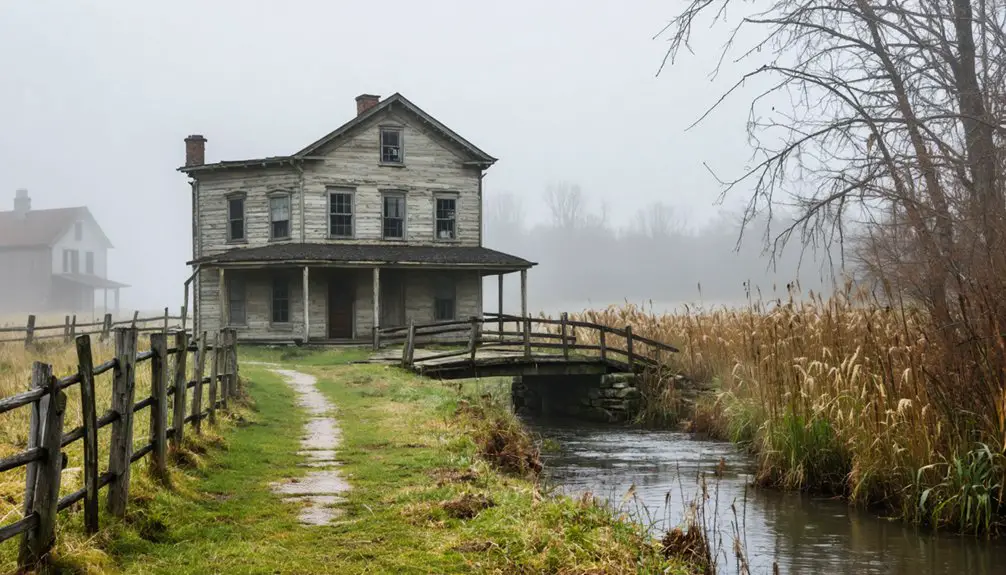When you visit Forestville, Minnesota today, you’ll find a preserved ghost town that transports you back to the 1890s. Once a bustling stagecoach stop, the town thrived until the railroad bypassed it in 1868, leading to its rapid decline. The powerful Meighen family eventually owned the entire settlement, running it as a company town until 1910. Now a state historic site, Forestville’s restored buildings and guided tours reveal the dramatic story of boom, bust, and preservation.
Key Takeaways
- Forestville became a ghost town after the Southern Minnesota Railroad bypassed it in 1868, causing businesses to close and residents to leave.
- The Meighen family acquired all major businesses and properties as residents departed, effectively turning Forestville into a company town.
- Population dropped dramatically from its peak to just 68 residents by 1870 as families relocated to nearby railroad-connected towns.
- The town’s final decline occurred when the Meighen store closed in 1910, marking the end of significant commercial activity.
- Now preserved as a state park, Forestville offers guided tours of historic buildings and provides visitors glimpses of 1800s Minnesota life.
Native American Lands and Early Settlement
Before European settlement transformed southeastern Minnesota, the region’s rich landscape sustained diverse Native American communities for thousands of years. The Dakota people dominated the area by the late 1600s, sharing the territory with Ho-Chunk, Ioway, Meswaki, and Fox peoples who valued the abundant fresh water, wildlife, and hardwood forests. Historic bridges later connected these early settlements.
Everything changed in 1851 when the Treaties of Traverse des Sioux and Mendota forced Native land cessions of 24 million acres to the U.S. government. This dramatic shift opened the door to settler impact, as European-Americans from New England, Canada, and Europe rushed to claim farmland. Within just a decade of the treaties, over 100,000 settlers moved into the newly opened territory.
The Rise of a Company Town
You’ll find Forestville’s transformation into a company town began with Thomas Meighen, who acquired the declining village’s properties and established an economic empire built on agriculture, retail, and lending.
While Meighen’s family controlled nearly every aspect of local commerce through their general store, farmland holdings, and worker housing, they benefited from Forestville’s position along stagecoach routes that still brought some outside trade to their businesses.
Meighen controlled the town’s economic destiny through ownership of 1,500 acres and the town store, where residents depended on credit for their basic needs. The town’s fortunes declined dramatically after the Southern Minnesota Railroad bypassed Forestville in 1868.
Meighen Family Business Empire
During the late 19th century, the Meighen family’s strategic acquisition of Forestville transformed the settlement into a company town centered around their thriving business operations.
Starting with Felix Meighen’s modest $700 investment in a general store, the family gradually purchased foreclosed properties as residents departed after the railroad bypassed the town. By 1889, they owned everything – the store, farms, and worker housing.
The Meighen legacy grew as they established a system of company dependency. Workers earned partial wages in store credit while renting homes from the family. Today, the store serves visitors as a perfectly preserved glimpse into small-town mercantile life of the 1800s. Living history interpreters in period dress bring the past to life through authentic reenactments.
Thomas Meighen later expanded the empire into banking and politics, becoming president of Preston’s First National Bank.
Though the family relocated to Preston by 1905, their influence shaped Forestville until the store’s closure in 1910.
Stagecoach Route Economic Influence
The establishment of the Dubuque-St. Paul Territorial Road in 1854 transformed Forestville into a bustling hub of stagecoach commerce.
You’d find swing stations every 15 miles where fresh horses awaited, while home stations provided travelers with lodging, meals, and postal services.
This network proved essential to Forestville’s growth as a company town. The steady flow of travelers created demand for the Meighen family’s general store, while farmers gained access to broader markets for their goods. The federal mail contracts incentivized stagecoach companies to maintain reliable service along the route.
You’ll notice how traveler influence shaped the local economy – businesses like blacksmiths, taverns, and supply warehouses sprung up to serve stagecoach traffic. Today, visitors can experience a 30-minute wagon ride showcasing these historic routes through the prairie.
Even property values increased as the town became a commercial node.
Yet when the Southern Minnesota Railroad bypassed Forestville in 1868, the town’s stagecoach-based prosperity began its slow decline.
Life Along the Stagecoach Route
Stagecoach travel through Minnesota’s southeastern frontier relied on a precise network of stops arranged every 15 miles along the Dubuque-St. Paul Territorial Road. You’d find these stops bustling with activity as weary travelers sought refuge and fresh horses for their journey. The village of Forestville emerged as a trade center in 1853, serving as a vital stop along the route.
- Home stations offered you meals, lodging, and a chance to mingle with fellow travelers at taverns that doubled as social hubs.
- “Swing” stations provided quick horse changes to keep the stagecoach dynamics flowing smoothly.
- General stores at major stops like Forestville created rural commerce networks where you could purchase supplies or arrange credit.
Local farmers and merchants built their livelihoods around these stagecoach arteries, with sawmills and chair factories springing up to serve both travelers and residents. The efficient network allowed stagecoaches to cover 105 miles per day across the Minnesota territory.
The stops weren’t just rest points – they were the heartbeat of frontier commerce and community life.
The Meighen Family Empire
Pioneering merchant Felix Meighen‘s modest $700 investment in a general store would eventually grow into complete ownership of Forestville itself.
By 1889, through a series of foreclosures and land acquisitions, the Meighen family controlled every aspect of the town’s operations. They transformed Forestville into a company town centered on their farming empire, where workers earned credit redeemable only at the Meighen store.
After Felix’s death in 1896, his son Thomas took command, expanding the family’s influence into banking and local politics.
But by 1905, changing times forced the Meighens to relocate to Preston. The store’s closure in 1910 marked Forestville’s end as a living town.
Today, you’ll find the preserved site within Forestville State Park, where the Meighen legacy lives on through their original store, home, and artifacts.
Railroad’s Impact and Town’s Decline

You’ll find the most pivotal moment in Forestville’s history came in 1868 when the Southern Minnesota Railroad chose to bypass the town in favor of a northerly route through Wykoff and Spring Valley.
This fateful decision cut Forestville off from the essential economic and transport networks that railroads provided in 19th century Minnesota, triggering an immediate population drop from its peak to just 68 residents by 1870.
As families and businesses relocated to prosperous railroad towns, Forestville’s role as a trading hub quickly faded, with most enterprises shuttering by the 1880s.
Railroad Bypass Impact
The Southern Minnesota Railroad‘s fateful decision to bypass Forestville in 1868 marked the beginning of the town’s swift decline. Instead of running through Forestville, the railroad infrastructure chose routes through Wykoff, Preston, and Spring Valley, positioning stations roughly 10 miles apart.
This strategic decision led to devastating community isolation that transformed Forestville from a bustling trade center into a dying town.
You’ll understand the impact through these stark changes:
- Population plummeted from 150 residents in 1860 to just 68 by 1870
- Local businesses, including sawmills, gristmills, and hotels, rapidly closed their doors
- The once-thriving stagecoach routes disappeared as rail travel became the dominant transportation mode
Without rail access, Forestville’s residents faced an impossible choice: stay and struggle or relocate to railroad towns for better opportunities.
Most chose to leave.
Economic Ripple Effects
When Forestville lost its chance at rail connectivity in 1868, devastating economic ripples spread far beyond the town’s immediate borders.
You can trace the rail significance through stark economic consequences – where connected Minnesota towns generated millions in rail-driven commerce, Forestville’s isolation cut it off from this prosperity.
The math tells a sobering story: each railroad job typically supported nearly four additional positions in related sectors, while every dollar invested in rail sparked $2.50 in broader economic activity.
Without these multiplier effects, Forestville couldn’t tap into the regional shipping networks that helped other Minnesota communities thrive.
While rail-connected towns saw their businesses grow through $1.3 billion worth of goods and services movement, Forestville’s enterprises withered from its railroad bypass.
From Bustling Hub to Abandoned Streets
During its heyday in the 1850s and 1860s, Forestville bustled with activity as an essential commercial hub in southeastern Minnesota. Settler experiences revolved around the Meighen’s general store, which served as both a commercial center and gathering place for the growing community.
The town’s economic changes tell a story of dramatic change:
From bustling frontier promise to quiet decline, Forestville’s economic journey mirrors the stark realities of America’s shifting frontier.
- In 1868, the railroad’s decision to bypass Forestville dealt a devastating blow to local commerce.
- By 1880, the once-thriving population had dwindled to just 55 residents.
- The Meighen family gradually acquired the entire town, operating the last remaining business until 1910.
You’d hardly recognize the transformation from a vibrant stagecoach stop to an abandoned settlement. As families sought opportunities elsewhere, Forestville’s streets grew quiet, its buildings emptied, and the once-bustling hub faded into history.
Preservation as a Historic Site

After decades of abandonment, Forestville found new life through dedicated preservation efforts beginning in 1949. When the Minnesota State Legislature authorized its protection as a state park, they guaranteed this slice of history wouldn’t fade away.
You’ll find the Minnesota Historical Society managing key structures like the Meighen General Store and family residence, where historic preservation maintains their authentic 1899 appearance.
Today, you can experience Forestville’s past through guided tours and special events like the Victorian Garden Party. Community engagement thrives as volunteers serve as Ghost Town Greeters, sharing stories and helping visitors enjoy period activities like croquet.
The site’s listing on the National Register of Historic Places protects these treasures while supporting local tourism and keeping Minnesota’s rural heritage alive for future generations.
Modern Tourist Experience and Legacy
Today’s visitors to Forestville step into an authentic slice of 1800s Minnesota life through guided tours departing every 45 minutes.
You’ll experience preserved buildings, including the Meighen Store, family home, and mill, while knowledgeable docents share stories of settler life and local Dakota history.
Tourist engagement options include:
Discover a range of interactive experiences at Forestville, where history and adventure blend seamlessly for visitors of all interests.
- Hands-on educational programs that bring pioneer and Native American history to life
- Self-guided hiking trails connecting historic structures and a fascinating old graveyard
- Seasonal camping at Mystery Cave State Park with traditional, electric, and horse sites
From Memorial Day through October, you’ll discover how railroad changes transformed this once-thriving community into a ghost town.
Whether you’re a history buff, outdoor enthusiast, or curious traveler, Forestville’s legacy as a preserved pioneer settlement offers an immersive journey into Minnesota’s past.
Frequently Asked Questions
What Did the Meighen Family Do With Their Wealth After Leaving Forestville?
You won’t find clear records of the Meighen legacy’s wealth redistribution after Forestville. Their departure in the early 1900s left questions about how they managed their assets and property holdings.
Were There Any Notable Crimes or Incidents in Forestville During Its Peak?
Envision this peaceful frontier town – you won’t find records of major crimes during its heyday. Despite whispers of unsolved mysteries and ghost sightings, historical documents show Forestville remained remarkably crime-free.
What Happened to the Original Town Records and Documents?
You won’t find many original town records today – most are missing documents due to archival challenges, abandonment, and environmental damage. Some materials may exist within Minnesota Historical Society’s collections.
Did Any Famous People Ever Visit or Stay in Forestville?
Of the 1,000+ visitors documented yearly at Historic Forestville today, none were famous in its heyday. You won’t find records of any notable historical figures visiting this locally-focused company town.
How Many Original Buildings From Forestville Have Been Completely Lost to Time?
While you can still explore some original structures of historical significance, most of Forestville’s buildings are gone – including the sawmills, blacksmith shop, hotel, distillery, post office, and numerous homes.
References
- https://www.startribune.com/ghost-towns-minnesota-nininger-forestville-old-crow-wing/601169483
- https://www.mngoodage.com/voices/mn-history/2019/07/a-ghost-town-turned-history-site/
- https://en.wikipedia.org/wiki/Forestville
- https://www.mnhs.org/forestville/learn/site
- https://www.cbsnews.com/minnesota/news/forestville-southern-minnesota-ghost-town-still-attracting-summer-visitors/
- https://www.mnhs.org/forestville/learn
- https://www.youtube.com/watch?v=PCWumyflcZI
- https://www.dnr.state.mn.us/state_parks/virtual_tour/forestville_mystery_cave/dialup.html
- https://visitminnesota.net/things-to-do/outdoor/historic-forestville-mn-state-park
- https://libguides.mnhs.org/forestville



